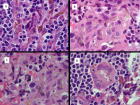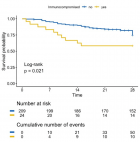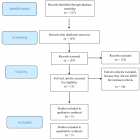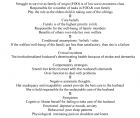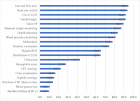Table of Contents
Sleep quality and Laboratory Findings in Patients with Varicose Vein Leg Pain
Published on: 24th June, 2023
Aim: This study aimed to investigate the association between sleep quality, as measured by the Pittsburgh Sleep Quality Index (PSQI), and laboratory findings in patients presenting with the complaint of leg pain due to varicose veins.Materials and Methods: A total of 160 patients with leg pain were included in this study. Sleep quality was assessed using the PSQI, and laboratory tests were conducted to evaluate ferritin, iron, vitamin B12, Thyroid Stimulating Hormone (TSH), C-reactive protein (CRP), albumin, low-density lipoprotein (LDL), and hemoglobin levels. Statistical analyses were performed using the independent t-test or Mann-Whitney U test for continuous variables and the chi-square test for categorical variables.Results: Patients with poor sleep quality had a significantly higher prevalence of leg pain complaints compared to those with good sleep quality (p < 0.001). Females were more likely to report poor sleep quality (p = 0.006). No significant associations were found between sleep quality and age, smoking status, alcohol use, or pack/year of smoking. Patients with poor sleep quality had significantly lower ferritin levels (p = 0.008), lower albumin levels (p = 0.031), and lower hemoglobin levels (p = 0.036) compared to patients with good sleep quality. However, no significant differences were observed in other laboratory parameters.Conclusion: The findings suggest a significant association between poor sleep quality and leg pain complaints in patients with varicose veins. Lower ferritin, albumin, and hemoglobin levels in patients with poor sleep quality may indicate potential underlying mechanisms linking sleep quality and leg pain. Addressing sleep quality issues in patients with leg pain could improve overall well-being and treatment outcomes.
Cost Variation Analysis of Various Brands of Anti-Depressants Agents Currently Available in Indian Markets
Published on: 21st June, 2023
Depression is a mental, psychiatric medical condition or disorder in which individuals manifest some clinical syndrome characterized by sadness, mood swings, societal withdrawal, lack of interest, family issues, and education problems which affect the daily student life in which the individual does not participate in daily activities. Sometimes individual commits suicide due to exam stress and that swings the mood upon the condition of the individual. The cost of brand-name medications prescribed in such circumstances exacerbates the disease burden and may even result in noncompliance with therapy. IDR (Indian Depository Receipt) was used to calculate the cost of various antidepressant drug brands. Using the percentage cost ratio, one can ascertain the price of each brand’s 10 tablets in INR (Indian Rupees), the cost ratio, and the percentage cost variance. The difference between the greatest and lowest prices of the same drug produced by Indian pharmaceutical industries was calculated. There is a greater price disparity between agents on the market. The greatest expense variance was found to be amitriptyline 25 mg (195%), fluoxetine 50 mg (95%), sertraline 50 mg (83%) and the lowest % cost variation was of fluvoxamine 20 mg (13.8 mg), duloxetine 20 mg (16%) and escitalopram 10 mg (38%). On the Indian market, the average price disparity between antidepressant medications of various brands is quite high. If a pricey brand is prescribed, patients will incur additional costs.
Considering antioxidant supplements as a means to prevent diseases
Published on: 27th April, 2023
Oxidative stress has been implicated in Alzheimer’s and many other diseases and more recently, it has been linked to various COVID-19-related symptoms. Many diseases do not develop immediately as a result of the accumulated causes or injury, but rather, as a result of prolonged exposure to elevated oxidative stress, which disrupts the body’s natural homeostatic functions.
Mercury toxicity and amyotrophic lateral sclerosis
Published on: 23rd March, 2023
Recent clinical, experimental and epidemiological studies report that ALS is thought possibly due to a multi-stage process, arising from a combination of genetic susceptibility and environmental factors, which alone or superimposed, perhaps on genetic polymorphism yet to be identified, may contribute to the incidence rate of sporadic ALS. In particular, a large amount of evidence suggests that mercury is toxic to motor neurons and may be a risk factor for ALS, playing a part in its pathogenesis. In fact, there have been case reports of ALS or ALS-like symptoms associated with mercury exposure, thus raising the possibility that mercury could be one of the non-genetic factors of the multistep process that is thought to underlie ALS. In order to give recent elucidations on the putative relationship between mercury exposure and ALS, we reviewed all the papers reported in the literature and published on Pubmed from 2006 to 2022. Despite a number of pathogenetic mechanisms that have been linked to mercury, evidence linking exposure to mercury to ALS is not consistent and discordant and, based on the evaluation of the articles, which emerged from our analysis that to date no convincing correlation between mercury and ALS has been established and no conclusive evidence has been enlightened suggesting increased mercury exposure is associated with ALS.
Case study (A and B): a patient with Parkinson’s disease
Published on: 15th March, 2023
Parkinson’s disease is a progressive and debilitating neurodegenerative disorder affecting millions of people worldwide. The disease is characterized by motor symptoms such as tremors, rigidity and postural instability, as well as non-motor symptoms such as depression and cognitive impairment. While there is no cure for Parkinson’s disease, there are various treatments available to manage symptoms and improve quality of life for patients.This case study examines a 65-year-old retired accountant, Mr. John Smith, who was diagnosed with Parkinson’s disease five years ago. Mr. Smith has been treated with a combination of medications, including levodopa and carbidopa and physical therapy to manage his symptoms. However, his symptoms have not significantly improved.This literature review explores the current research on Parkinson’s disease, including its pathophysiology, diagnosis and treatment. Parkinson’s disease is caused by the degeneration of dopamine-producing neurons in the brain, leading to a depletion of dopamine and the accumulation of alpha-synuclein protein, oxidative stress and inflammation. Diagnosis is based on clinical symptoms, neurological examination and response to dopaminergic therapy. Treatment focuses on managing symptoms, with medications and non-pharmacological interventions such as exercise and physical therapy. Deep brain stimulation is a surgical treatment option that has been shown to be effective in managing motor symptoms.While there is currently no cure for Parkinson’s disease, ongoing research into its pathophysiology and treatment holds promise for improving outcomes for patients. This case study highlights the importance of early diagnosis and personalized treatment plans for patients with Parkinson’s disease.
Case report: contrast imaging in the setting of venous thrombosis
Published on: 28th February, 2023
Disruption to contrast agent supply chains for radiology investigations has become an additional consequence of the COVID-19 pandemic. Various recommendations, including dose reductions and choices of alternative agents, have been made to help account for this limited availability. This case demonstrated how two separate CT venograms with different contrast agents, undertaken on the same day for the same patient, yielded different results; venous thromboses were more prominent in the subsequent scan. Although there was some evidence of venous sinus thrombosis on the first scan, repeat imaging was required to further characterize the lesions identified. The case exemplifies the notion that diagnostic imaging should always be guided by a detailed history and examination. It also raises the discussion point of whether more strict or uniform protocols should be developed to facilitate contrast administration for radiology investigations. It is important that appropriate doses are always administered to maximize diagnostic yield.

HSPI: We're glad you're here. Please click "create a new Query" if you are a new visitor to our website and need further information from us.
If you are already a member of our network and need to keep track of any developments regarding a question you have already submitted, click "take me to my Query."






